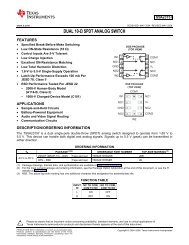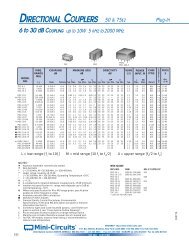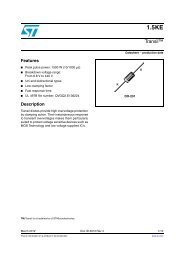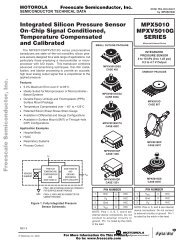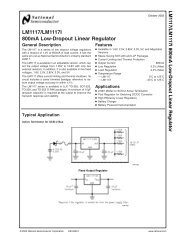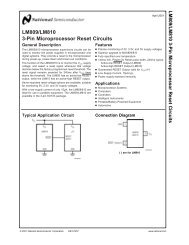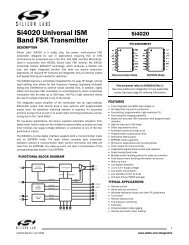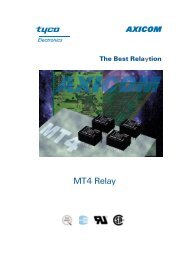LM3445 Triac Dimmable Offline LED Driver
LM3445 Triac Dimmable Offline LED Driver
LM3445 Triac Dimmable Offline LED Driver
You also want an ePaper? Increase the reach of your titles
YUMPU automatically turns print PDFs into web optimized ePapers that Google loves.
<strong>LM3445</strong><br />
Symbol Parameter Conditions Min Typ Max Units<br />
CURRENT SENSE COMPARATOR<br />
V FLTR2 FLTR2 open circuit voltage 720 750 780 mV<br />
R FLTR2 FLTR2 impedance 420 kΩ<br />
V OS Current sense comparator offset voltage -4.0 0.1 4.0 mV<br />
GATE DRIVE OUTPUT<br />
V DRVH GATE high saturation I GATE = 50 mA 0.24 0.50 V<br />
V DRVL GATE low saturation I GATE = 100 mA 0.22 0.50<br />
I DRV Peak souce current GATE = V CC /2 -0.77 A<br />
Peak sink current GATE = V CC /2 0.88<br />
t DV Rise time C load = 1 nF 15 ns<br />
Fall time C load = 1 nF 15<br />
THERMAL SHUTDOWN<br />
T SD Thermal shutdown temperature (Note 5) 165 °C<br />
Thermal shutdown hysteresis 20<br />
THERMAL SHUTDOWN<br />
R θJA<br />
MSOP-10 junction to ambient 121 °C/W<br />
Note 1: Absolute maximum ratings are limits beyond which damage to the device may occur. Operating Ratings are conditions for which the device is intended<br />
to be functional, but device parameter specifications may not be guaranteed. For guaranteed specifications and test conditions, see the Electrical Characteristics.<br />
Note 2: All voltages are with respect to the potential at the GND pin, unless otherwise specified.<br />
Note 3: Internal thermal shutdown circuitry protects the device from permanent damage. Thermal shutdown engages at T J = 165°C (typ.) and disengages at T J<br />
= 145°C (typ).<br />
Note 4: Human Body Model, applicable std. JESD22-A114-C.<br />
Note 5: Junction-to-ambient thermal resistance is highly application and board-layout dependent. In applications where high maximum power dissipation exists,<br />
special care must be paid to thermal dissipation issues in board design. In applications where high power dissipation and/or poor package thermal resistance is<br />
present, the maximum ambient temperature may have to be derated. Maximum ambient temperature (T A-MAX ) is dependent on the maximum operating junction<br />
temperature (T J-MAX-OP = 125°C), the maximum power dissipation of the device in the application (P D-MAX ), and the junction-to ambient thermal resistance of the<br />
part/package in the application (R θJA ), as given by the following equation: T A-MAX = T J-MAX-OP – (R θJA × P D-MAX ).<br />
www.national.com 4



